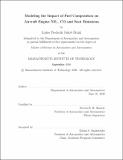Modeling the impact of fuel composition on aircraft engine NOx̳, CO and soot emissions
Author(s)
Brink, Lukas Frederik Jakob.
Download1227278199-MIT.pdf (1.710Mb)
Other Contributors
Massachusetts Institute of Technology. Department of Aeronautics and Astronautics.
Advisor
Steven R. H. Barrett.
Terms of use
Metadata
Show full item recordAbstract
Aircraft NO[subscript x], CO and soot emissions contribute to climate change and lead to negative air quality impacts. With the aim of quantifying the effects of fuel composition on NO[subscript x], CO and soot emissions, a combustor model named Pycaso is developed. The combustor model consists of a 0D/1D reactor network, coupled with a soot model. The model predicts NO[subscript x], CO and soot emissions at sea level conditions for a CFM56-7B engine using conventional jet fuel. The model matches existing methods to predict cruise NO[subscript x] emissions within 5% and cruise CO emissions within 30%. It is shown that the volume -- and thus time -- over which secondary air is mixed with the fuel-air mixture in the combustor is the most important factor in determining the magnitudes of the modeled emissions. The sensitivity of modeled NO[subscript x] and CO emissions to thrust at thrust settings below 15% is shown to be the consequence of "cold" unburned fuel entering the secondary zone of the combustor. The model is used to assess two possible emission mitigation solutions: removing naphthalene from jet fuel and replacing conventional jet fuel with 50:50 biofuel blends. The removal of naphthalene through hydrotreating is found to lead to mean reductions in soot emissions of 15% [12%-20%] for mass and 9% [5%-19%] for number. The range captures variations in engine operating conditions, soot model configurations and compositions of the baseline jet fuel. Similarly, the removal of naphthalene through extractive distillation reduces soot mass emissions by 32% [29%-48%] and number emissions by 23% [14%-45%]. The mean reductions associated with using 50:50 biofuel blends are 43% [34%-59%] for soot mass and 35% [14%-45%] for soot number. Using biofuel blends is also predicted to result in a reduction in NO[subscript x] emissions of 5% [4%-7%] and a 3% [2%-4%] decrease in CO emissions.
Description
Thesis: S.M., Massachusetts Institute of Technology, Department of Aeronautics and Astronautics, September, 2020 Cataloged from student-submitted PDF of thesis. In title on title page, x̳ appears as subscript x. Includes bibliographical references (pages 103-114).
Date issued
2020Department
Massachusetts Institute of Technology. Department of Aeronautics and AstronauticsPublisher
Massachusetts Institute of Technology
Keywords
Aeronautics and Astronautics.